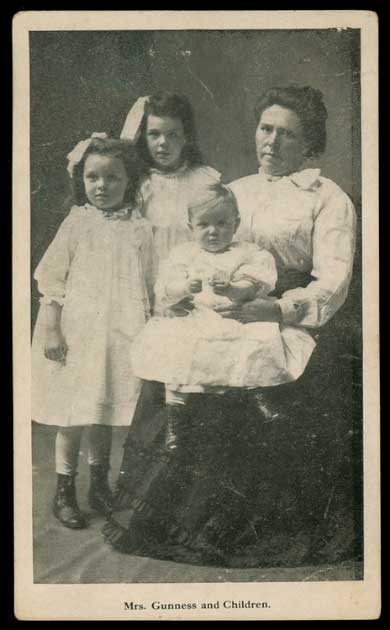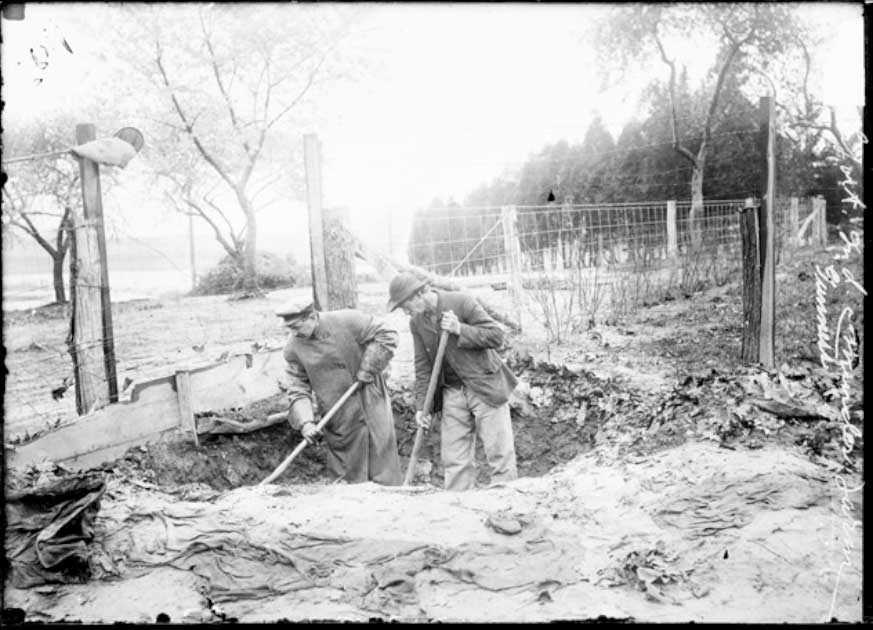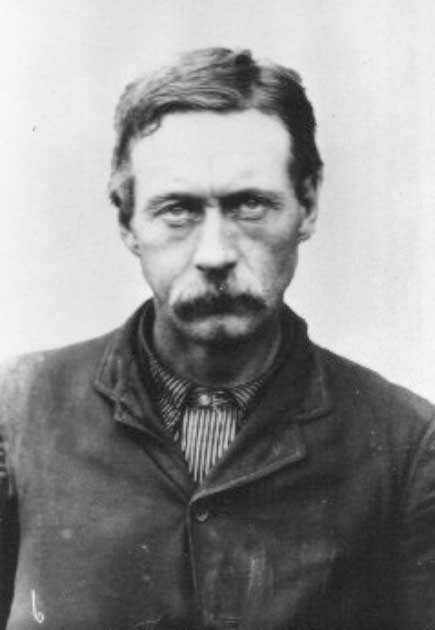You might notice a trend if you are into true crime; people seem to talk mainly about male serial killers. What about women? A myth that has been believed, even by FBI investigators, is that there are no female serial killers.
Women are too gentle, loving, weak, or scared, making them the victims of serial murder, not the perpetrators. It was assumed that a female killer couldn’t kill the required three confirmed victims, classifying someone as a serial killer. It is assumed to be not in their nature, but this is a fatal assumption.
The “Starvation Doctor” Linda Hazzard killed 15 people at the start of the 20th century. Licensed nurse Genene Anne Jones is believed responsible for the deaths of up to 60 babies and young children in her care.
Then there was Belle Gunness. She is responsible for killing so many victims that investigators stopped counting the number of remains found on her property. Known by the spectacular nicknames The Bluebeard in Skirts and Hell’s Belle, Belle Gunness was the talk of La Porte, Indiana, for years after her crimes were unearthed.
Belle Gunness
Belle Gunness, birth name Brynhild Paulsdatter Størset, was born in Selbu, Sør-Trøndelag, Norway, on November 11, 1859. In 1881, when she was 21 years old, Belle Gunness moved to Chicago. She changed her name to Belle Petersen and moved in with her sister Nellie and her husband, who had immigrated a few years before Belle did.
In Chicago, Belle Gunness worked as a maid but eventually became a butcher. Having grown up on a farm, Belle knew how to cut meat and was said to have been very strong. It is believed that she stood around 5’7’’ (170cm) and weighed about 210-250 lbs (95-113kg), and had been described as “masculine in appearance.”

In 1884, Belle Gunness married a fellow Norwegian immigrant Mads Sorenson. The happy couple owned a candy store and looked after foster children. The candy shop Belle Gunness owned was far from successful however, and after a year, a fire broke out and burned the store to the ground.
Luckily, the business was insured, and Belle Gunness told investigators that the cause of the fire was an exploded kerosene lamp. No such lamp was found, but the investigators gave Belle the insurance money. Not long after the payout, the couple bought their first home, which also was destroyed by a fire in 1898.
Horrible misfortune seemed to latch onto the family in the form of the deaths of two children. The children were infants when they died from acute colitis. Colitis is a digestive disease that can cause cramping, lower abdominal pains, fever, nausea, and diarrhea. It should be noted that these are also some symptoms that occur after ingesting the poison strychnine.
The infants were insured, and the money paid out. Mads himself also had an insurance policy but was encouraged by Belle to take out a second and larger policy. Mads died mysteriously on the day his two insurance policies overlapped, which the neighbors found suspicious.
But they had no evidence. With the large sum of money from her husband’s unfortunate death, Belle was financially stable and bought a farm in La Porte, Indiana, and three foster children moved with her to the new farm in 1901.
In the spring of 1902, Belle married Peter Gunness, a widower who had been left with two young daughters. The youngest Gunness girls died about a week after the marriage, and Peter died eight months later.
- Belle Starr: Midwestern Bandit Queen of the 1800s
- The Bloody Benders: What Happened to this Family of Killers?
Authorities were told how Peter had reached up to grab something from a top shelf, and a sausage grinder fell on his head and killed him. The authorities in La Porte knew nothing about Belle Gunness’ first husband and his mysterious death. Had they known this was her second dead husband, would the lives of dozens of other men be spared?
Lonely Hearts Ads
Not long after the death of Peter, Belle Gunness began placing ads in three weekly Norwegian newspapers in the American Midwest. The ads stated that a wealthy widow with a farm was looking for a good, kind, and reliable man to marry.

The exact number of men who responded to Belle Gunness’s lonely hearts ads is unknown, but we know many men went to pay her a visit in hopes of marriage. Family members of the men would often never hear from them again. Belle Guinness would admit she knew the men; and that they stayed with her, and she even had some of their belongings. But she was adamant that they all had left, and that she never heard from them again.
These men all did similar things before visiting Belle Gunness. They all took large amounts of cash from their bank accounts and gave it to Belle, would tell only a few people or none where they were going, and disappear off the face of the earth.
Obviously, something was not right at the Gunness farm, yet nobody in La Porte seemed to notice. That was until one man, Andrew Helgelien, had his suspicions aroused when his brother left to see Gunness without a word to his family, and then failed to return or send word of his well-being.
When questioned by Helgelien, Belle Gunness told him that she didn’t know his brother and that he was welcome to come to look around the farm to see that his brother wasn’t there. Belle Gunness’ get-rich-quick grift looked like it was catching up with her.
Another Fire and Soft Depressions
Late one night in April 1908, Belle Gunness’s farmhouse burned to the ground. When La Porte authorities could get to the site, they found the bodies of three children and a woman. Oddly, the woman’s body was missing its head, and the remains looked much smaller than Bell Gunness’s tall and broad body.
Andrew Helgelien, still suspicious that Gunness had killed his brother, contacted the La Porte police and made sure to look around the farm after she died. Helgelien and a former farm employee began to look around the property. The former employee mentioned “soft depressions” he noticed inside an area that had been a hog pen.
Authorities dug into one of these soft depressions and found a sack buried under the soil. The bag was opened, and its contents horrified, changing how the public and police saw Belle Gunness. The bag contained “two hands, two feet, and one head,” and quicklime was stuffed into the mouth and ears of the head in the bag.
That is when Helgelien recognized the limbs in the bag: sadly, it was his brother. Belle Gunness’s farm was searched, and authorities noticed many of the same soft depressions all over the yard. In each depression was a burlap sack filled with arms, legs, and torsos with “loose flesh that dripped like jelly”.

All the bodies found on the farm were killed the same way. After using blunt force trauma to kill her victims, Belle Gunness would decapitate her victim, and like she used to do when she worked as a butcher, she removed the arms at the shoulders and legs at the knees. Many of the heads were covered in a dusting of Quicklime and wrapped up in a burlap sack.
The authorities found so many bags that they stopped counting. Although Helgelien was lucky and could recognize his brother’s remains, most of the bags contained remains that could not be identified. People would come to watch the removal of the bags and attempted assembly of the parts. Refreshment stands were set up, and the people (as many as 15,000 in a single day) could buy a nice hearty bowl of “Gunness stew” to enjoy while watching the morbid scene unfold.
A former hired hand named Ray Lamphere, who worked on the farm and was an on-again-off-again lover of Belle Gunness, had been seen to threaten her after she fired him. He was quickly arrested for the arson and murder of the Gunness family.
- The Lava Lake Murders: A Horror Movie Come to Life?
- The Blood Countess of Hungary: Was Elizabeth Báthory a Vampire?
Belle Gunness’s former lover admitted that he went by the farm and saw it was on fire but feared that if he told anyone, he would end up incriminating himself. He was right; Ray was sentenced to imprisonment in Indiana State Prison.
Not long after the sentencing, Ray died of tuberculosis and gave an interesting deathbed confession. Ray said that he didn’t kill anyone but did help Belle Gunness bury the sacks of body parts. He also took credit for the fire, but the woman’s body found in the home was not Gunness.
It was, instead, her housekeeper. Ray said that he had taken Gunness to a train station, and she hopped on a train headed to Chicago. Ray noted that Belle Gunness killed and decapitated the housekeeper and her children and placed them in the basement so it would look like an accident had killed the family.
Did Belle Gunness Fake Her Own Death?
Police investigated the claims made by Ray in his deathbed confession. No information was recovered about Belle Gunness’s whereabouts or the true identity of the headless woman’s body.
For the twenty years that followed the fire at the Gunness farm, people have reported sightings of “Hell’s Belle” as she was called in the media. None of the confirmed sightings have been confirmed, and to this day, what happened to The Bluebeard in Skirts, Hell’s Belle, is still a mystery.

It wouldn’t have been that difficult for Belle Gunness to fake her own death and go on the run. She could move to another state or city, assume a new identity, and hide in plain sight. The lack of technology at that time would have made Belle’s escape much easier than if the same crime had been committed today.
Is it possible she faked her death and went to live a new life as someone else? Yes, it is possible. However, it is just as likely that the headless body found after the fire was Belle Gunness.
The much smaller-sized corpse recovered in the remains of the Gunness house has led many people to claim that it is proof that Belle Gunness faked her death. The fire however can explain the three or four-inch height difference between the body and Belle Gunness.
When someone dies in a fire, the first thing that happens is the skin, and soft tissue of the body will be burnt off. What is left is exposed skeletal muscles that contract and shrink in response to the heat. It is what causes some victims of fires to be found with their arms and hands in pugilistic condition (arms folded tight to the body and wrists curled like a boxer in a ring).
It only takes a body 10 minutes to shrink and draw into this pugilistic form. What about the missing head? A victim’s head is made of relatively thin soft tissues, and the lack of clothing on the head and face mean that the skull is where the most burns and heat-related lesions will appear.
The body may have been decapitated and staged, as Ray claimed, but it is not uncommon to find the body of someone who died and was burned in a fire that is missing limbs. The destruction of the soft tissue and damage to the muscles can cause thermal amputation.
It has also been found that not all body parts burn the same. One arm might burn much faster than another. Because the head has more soft and exposed tissue, it will burn fast. That is why you hear about identifying bodies from dental records in instances of fire.

It is unknown how long the fire at the Gunness farm burned for, how hot it was, or if any accelerants were involved or found in the house’s ashes. The severity of the children’s burns or if they were found in a pugilistic position was not mentioned in any reports on the incident; all we know is that the woman was missing a head.
The lack of information about the fire, the forensic effects of death by fire, or the condition of all victims makes it difficult to say with certainty the body was not Belle Gunness. Her head may have been destroyed by thermal amputation. She could have faked her death, or paid for her crimes with her own life.
Top Image: Belle Gunness killed countless men for money, and may have got away with it. Source: Master1305 / Adobe Stock.
By Lauren Dillon